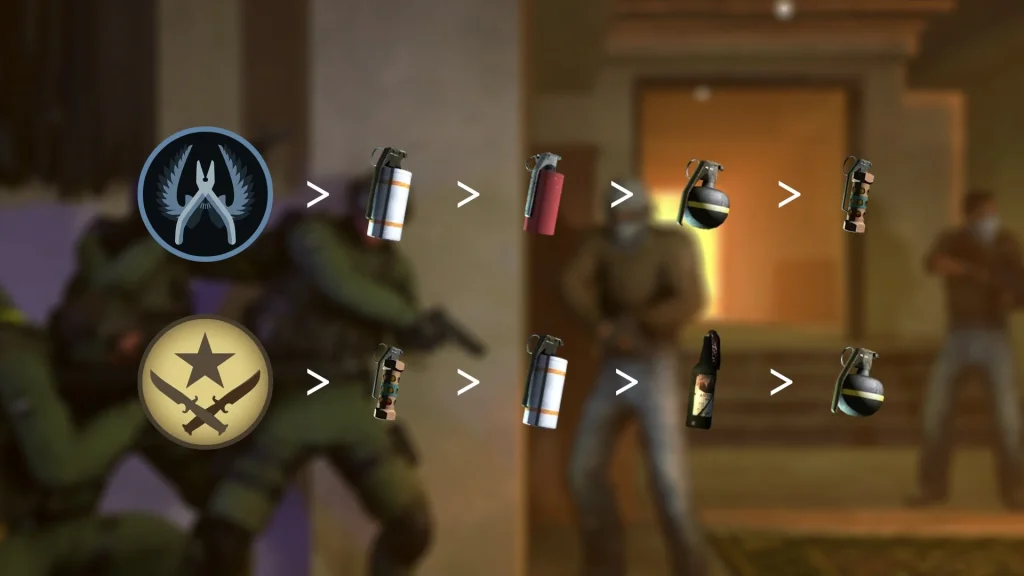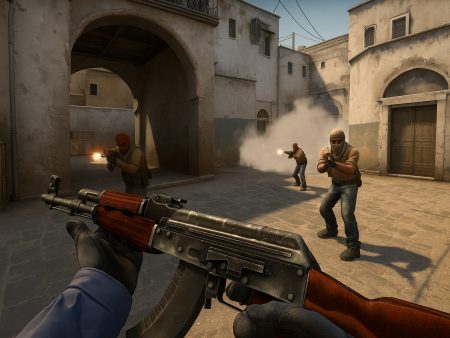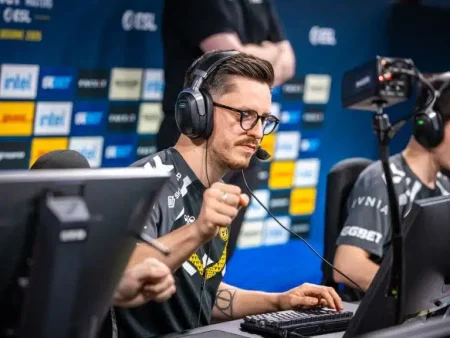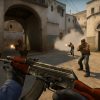Master the AWP in CS2 with this complete sniping guide. Learn pro strategies, positioning, aim tips, utility usage, and how to dominate matches with the big green gun. Perfect for beginners and advanced players alike.
Introduction to the AWP in CS2
What is the AWP?
The AWP, short for Arctic Warfare Police, is the most iconic sniper rifle in Counter-Strike 2 (CS2). Known for its raw power, the AWP can eliminate an opponent with a single shot to the chest or head. It’s a high-risk, high-reward weapon that costs a hefty $4,750 in-game, making it one of the most expensive weapons in the CS2 arsenal.
In CS2, just like its predecessors, the AWP has maintained its reputation as the go-to gun for skilled snipers. The gun has a slow rate of fire, heavy movement penalty, and a loud firing sound, making it hard to use effectively without solid game sense and aim. However, in the hands of a trained player, the AWP becomes a game-changing tool that can lock down entire bombsites or break enemy momentum with a single well-placed shot.
Its unique attributes force players to play smarter, anticipate enemy moves, and choose their battles carefully. Every shot counts with the AWP—miss once, and you might be punished immediately. But hit your mark? You can turn the tide of a round in seconds.
Importance of the AWP in Competitive Play

In competitive CS2, the AWP is more than just a powerful gun—it’s a tactical weapon that can shape how an entire team plays. Having a competent AWPer on your team opens up a wide range of strategies. Whether it’s holding down mid on Mirage or denying Banana control on Inferno, an AWP in the right hands can shut down enemy advances before they even begin.
On the CT side, AWPers are usually tasked with anchoring key parts of the map or controlling chokepoints. Their presence forces enemies to use more utility, change their routes, or even avoid certain areas completely. On the T side, an AWPer can be the spearhead—picking off defenders from a distance and creating openings for the rest of the team to push through.
In pro play, we often see teams build entire buy rounds around their AWPer. If their star sniper has the money to buy the big green gun, they’ll adjust their strategies to maximize that weapon’s impact. This level of respect for the AWP shows just how crucial it is to team success.
Understanding the Basics of Sniping
Sniper Roles and Responsibilities
Sniping isn’t just about hitting flashy headshots or landing lucky no-scopes. It’s about control, positioning, and discipline. A sniper’s main role is to gain information, hold key angles, and get opening picks that can lead to round wins. That means knowing where to position yourself, when to take the shot, and when to fall back.
In CS2, the AWPer often plays as a lurker or anchor on the CT side, depending on the map. You might be the player locking down long A on Dust II or watching apartments on Inferno. Your presence can delay enemy pushes, force out utility, or even completely deny map control. On the T side, your job is to find gaps in the defense—catch rotating players, punish over-aggression, or open up bomb sites with clean entries.
As a sniper, your responsibilities extend beyond just frags. You must stay alive, save the AWP when needed, and communicate enemy positions clearly. Your role demands a higher level of awareness since losing the AWP early can be a massive setback to your team’s economy and game plan.
Mental Preparation for a Sniper
Great AWPers aren’t just good aimers—they’re mentally sharp and composed. The pressure of holding a crucial angle while knowing the enemy could peek at any moment can get to your head. That’s why mental toughness is key. You need to stay calm under pressure, make smart decisions, and not get tilted if you miss a shot.
Confidence is another huge factor. Doubting yourself causes hesitation, and hesitation is deadly when AWPing. You have to trust your positioning, your reaction time, and your game sense. If you take the shot, commit. If you miss, fall back and reposition rather than panicking.
A good AWPer also knows how to control the pace of the game. Sometimes, the threat of the AWP is more powerful than the AWP itself. By simply being present in certain positions, you can slow down enemy plays, force bad decisions, and tilt your opponents into making mistakes.
Mastering the AWP Mechanics
AWP Firing Mechanics and Timing
The AWP doesn’t forgive poor timing. Unlike rifles, it doesn’t have a fast rate of fire or a wide margin for error. After each shot, there’s a long bolt animation that forces you to either commit to the angle or fall back. That’s why understanding your timing is so crucial.
In CS2, the firing mechanics of the AWP have subtle changes compared to CS:GO. The new sub-tick system means that your shot registration depends more on precision and movement than ever before. To be effective, you must master the concept of “stop-shoot”—stop moving entirely before shooting to maintain full accuracy.
This takes practice. You can’t just scope in and shoot while walking or jumping. That’s a recipe for disaster. Instead, learn to counter-strafe: tap the opposite movement key to stop on a dime before you pull the trigger.
Knowing when to take the shot is just as important. Sometimes it’s better to wait half a second and get a guaranteed kill rather than taking a rushed shot that gives away your position. That extra half-second can be the difference between winning and losing the round.
Movement and Accuracy (Scope, Walk, Crouch)
Every AWPer should be familiar with how movement affects accuracy. If you’re moving while scoping or shooting, your bullet will go nowhere near your crosshair. That’s why positioning is key—you need to put yourself in spots where you can be stationary and safe.
Walking (Shift key) reduces your movement noise, which is useful for sneaking into angles, but you’ll still need to stop before firing. Crouching can help stabilize your shot and make you a smaller target, but don’t overdo it or you’ll become predictable. Smart AWPers mix up their posture—standing, crouching, or quick-scoping to keep enemies guessing.
Scope usage is another element that separates good AWPers from great ones. There are two zoom levels—use the low zoom (right-click once) for medium distances and high zoom (right-click twice) for long-range peeks. Switching between zooms takes time, so pre-plan your angles.
You should also learn quick-scoping—not the kind you see in montages, but the practical kind where you scope and fire nearly simultaneously after stopping. This lets you react faster in tight situations without compromising accuracy.
Aiming and Crosshair Placement
Pre-Aiming and Holding Angles
Pre-aiming is the foundation of consistent AWPing. Instead of reacting to where the enemy might be, you position your crosshair exactly where their head or body is most likely to appear. This means knowing common spots—where players peek from, where they hold, and how they move.
Holding angles is about discipline. You don’t need to flick all the time. Sometimes, the best shot is the easiest one—if you’re already holding the correct line and the enemy walks into it, that’s a free kill. Let them make the mistake of peeking you.
There are two types of angles: tight angles and wide angles. Tight angles reduce your exposure, but also limit your reaction time. Wide angles give you more vision, but make you vulnerable. Depending on the situation, choose the right one. Don’t always default to the same angle or you’ll become predictable.
Crosshair placement also matters when moving between positions. Keep your crosshair level with head height and centered where enemies are likely to appear. That way, you only have to make vertical or horizontal adjustments when firing—not both.
Best AWPing Positions on Popular Maps
Mirage: Mid, Window, and Cat Control
Mirage is a haven for AWPers due to its long sightlines and strategic mid control. The Window position is perhaps the most iconic AWPing spot in all of CS. From there, you can control Connector, Top Mid, and even Peek Catwalk with ease. With a good spawn and a teammate throwing a Window smoke, you can take control early and pick off careless T-side players trying to take mid.
Another strong position is Catwalk. Once you’ve pushed up, Cat allows you to swing into Mid Boxes or Underpass, catch lurkers off-guard, or support B short from a distance. Good communication with your connector player can create a deadly crossfire setup.
On the T side, AWPing from Top Mid lets you counter the CT AWPer in Window or Connector. Patience is key here—hold for aggression, punish rotates, and use your AWP to open the map. If you’re feeling spicy, consider peeking into Window with a flash support and going for an early pick. Mirage rewards confident, smart AWPing.
Inferno: Banana, Mid, and B Site
Inferno is a bit tighter, but it still offers plenty of juicy AWP angles. Banana is a classic battleground for AWPers. On CT side, you can peek down Banana early for picks, but make sure you have molly and flash support. A good smoke lineup and an early pick can give your team complete control of the map’s tempo.
From B Site, playing behind new box or coffins allows for quick flicks onto T-rushes or delayed peeks into CT spawn. AWPers holding B can either anchor or rotate quickly to A if needed—Inferno rewards smart positioning over raw aggression.
Mid on Inferno is narrow, but on the T side, you can post up behind logs or second mid and wait for peeks. Using the AWP here requires patience—you’re playing a mental game, waiting for the CT to overstep. If they don’t, push slowly with your team, AWP leading the way to clear angles.
Dust II: Long Doors, Mid Doors, A Site
Dust II has some of the longest AWP lines in CS2. On CT side, Long Doors is an early contest spot. A fast peek with a spawn advantage can net you a kill, but it’s risky. Better yet, hold from Car or Pit with support—these defensive angles let you land your shots without being easily traded.
Mid Doors is where a lot of the action happens. A good mid AWPer can control Catwalk pushes, watch Lower Tunnels, and even stop Xbox jumps. On the T side, a sniper watching CT Mid or holding long-range angles outside B can open up the round instantly.
From A Site, holding from Ramp or Goose lets you control Cat and Long at the same time. Combine your AWP with a rifler watching short, and you’ve created a fortress. The open nature of Dust II makes it a playground for confident snipers.
Utility Usage to Support AWPers

Smokes, Flashes, and Molotovs for AWP Play
Utility is the AWPer’s best friend. A well-thrown flash can get you a free kill. A perfect smoke can let you reposition. A molotov can force your enemies into your crosshair. You’re not just a sharpshooter—you’re a tactician.
Let’s start with smokes. As an AWPer, you can use them to block off enemy vision or isolate duels. Need to take mid control on Mirage? Smoke Top Mid, then peek from Window. Holding B on Inferno? A CT smoke can delay rushes and force bad decisions.
Flashes are your lifeline. If you’re solo peeking an angle, use a pop-flash—one that explodes instantly in the enemy’s line of sight. You can also ask teammates to flash for you, especially when contesting areas like Banana or Long A. Don’t dry peek without some form of support.
Molotovs work great with AWPing too. You can flush out angles, prevent rushes, or cut off enemy rotations. Mollying under Balcony on Mirage forces enemies to jump into your scope. Mollying Sandbags on Banana stops aggressive Ts from hiding in early rounds.
The key? Combine your utility with good timing and positioning. Don’t waste it. Plan your AWP plays around when and where utility will give you an advantage.
How to Use Utility Defensively as an AWPer
On defense, your utility should be used to buy time, block pushes, and reposition safely. For example, if you’re holding B Site on Mirage, drop a smoke at the entrance, delay their push, and rotate to Van or Bench to hold a tighter angle.
Flash defensively to disengage. If you miss your shot and need to fall back, throw a flash off a wall and reposition immediately. It keeps the enemy from chasing you down and gives you another chance to fight from a better position.
Molotovs are underrated in the AWPer’s kit. Use them reactively. Hear footsteps? Molotov the entrance. Know they’re setting up an execute? Drop a molly to break their timing.
Defensive utility isn’t just about stalling—it’s about playing smart. You want to force enemies to move where you want them, then pick them off when they least expect it. A smart AWPer can turn a 1v3 into a clutch by using utility correctly.
Advanced AWP Strategies
Aggressive vs. Passive AWPing
Every AWPer has a unique style. Some love the thrill of aggressive peeks. Others prefer to anchor and punish mistakes. The best AWPers know how to do both—and when to switch between the two.
Aggressive AWPing is all about taking initiative. Push up Mid, peek early, surprise your enemies. This works best when you have support, good spawn, and the confidence to hit your shots. The element of surprise is your biggest weapon here.
But don’t overdo it. Aggression without backup can lead to you dying early and losing the AWP. That’s why map knowledge and timing are so important. Learn the best peeks for each map and only go aggressive when it makes sense.
Passive AWPing, on the other hand, is more about playing the long game. Holding angles, waiting for peeks, and anchoring bombsites. It’s less flashy but just as impactful. It puts pressure on the enemy to make the first move—and when they do, you’re ready.
The magic happens when you can switch between both styles mid-game. Start off aggressive to throw off their rhythm. Next round, play back and let them walk into your scope. Keep them guessing and you’ll stay one step ahead.
Rotating and Repositioning Mid-Round
Good AWPers don’t stay static. Once you get a kill or make contact, you need to reposition. Why? Because the enemy now knows where you are, and they’ll avoid or counter you next time.
Repositioning could mean falling back to a safer angle or rotating to a different site entirely. Did you get a pick Mid on Mirage? Move to B or Cat next round. Caught someone Long on Dust II? Hold from Goose or CT Ramp the next time.
Mid-round rotations are also key. As the round develops, your team might call for help at another site. Rotate quickly but smartly. Don’t just sprint across open ground. Use smokes and flashes to cover yourself or go through spawn routes.
A good AWPer makes themselves unpredictable. Never hold the same spot more than twice in a row. Make it so the enemy has to spend extra time and utility just figuring out where you are. That mental edge is priceless.
Economy and the AWP
When to Buy the AWP
The AWP is expensive. You need to know when it’s worth the risk. As a general rule, only buy the AWP if:
- You have armor and utility to support it.
- Your team can still buy full rifles and nades.
- You’re confident you can make an impact.
Buying the AWP on a half-buy or force-buy can be risky. If you die early, it’s a massive economic loss. But in certain situations—like holding down B site solo—it might be justified.
Coordinate with your team. Don’t just buy AWP every round and expect them to support you. If you’re the main AWPer, they might drop it to you on key rounds. Value the weapon and treat it with care.
Eco Round AWPing Strategies
Sometimes you find yourself with only a few dollars and an AWP saved from the previous round. These are eco rounds—low economy, high risk. But with the AWP, they’re not hopeless.
Play passive and look for picks. Hold tight angles where you can get a kill and fall back. Don’t overpeek—your goal is to get one or two kills and upgrade your teammates’ guns.
You can also try baiting. Let your pistol teammates peek first, then trade with your AWP. The chaos can create windows for you to land kills.
Remember: every shot counts. You don’t have money to rebuy. Be efficient, be patient, and don’t waste the gun.
Communication and Team Synergy
Calling Out Enemy Positions
As an AWPer, you often have the best vision on the map. Use that to your advantage. If you see someone peeking Mid or jumping Cat, call it out immediately. Precise callouts can win rounds—don’t just say “he’s there.” Say “AWP Mid Window,” “1 underpass,” or “crossing to B.”
Being vocal also helps your riflers position better. If you’re watching Mid, let your team know so they can focus on other areas. If you’re rotating, announce it early so no one is caught off guard.
Clear communication builds trust—and with trust, your team can execute strategies that let your AWP shine.
Working With Riflers and Entry Fraggers
Your rifle teammates are your backbone. They throw your flashes, watch your flanks, and create space. As an AWPer, learn to work with them.
Coordinate peek timings. Let them go first, trade if they die, or swing together to surprise enemies. Use your rifle teammates to flush out corners you can’t clear with your scope.
Entry fraggers also love a reliable AWPer. You can cover them as they enter sites, hold post-plant angles, or shut down retakes. Don’t isolate yourself—work as part of a team.
A lone AWPer can win fights. A well-supported AWPer can win games.
Practicing and Improving AWP Skills
Aim Training Maps and Routines
To get good at AWPing, you need more than just match experience—you need structured practice. CS2 offers a variety of aim training maps, and you should make them part of your daily warm-up. Two community favorites are “Aim Botz” and “training_aim_csgo2”—they still work well in CS2 and help you drill reflex shots, tracking, and quick-scoping.
Here’s a sample daily AWP routine:
- Warm-up (10 minutes): Use Aim Botz or a similar map. Focus only on hitting head and chest shots while standing still. Simulate real AWP movement—stop, scope, shoot, reset.
- Flick training (10 minutes): Use training_aim_csgo2 or Aimbotz with moving bots. Practice fast flicks left and right, mimicking common angles.
- Scope timing drills (5 minutes): Practice quick-scoping into targets and firing immediately. Focus on rhythm and reaction speed.
- Angle holding practice (10 minutes): Load a map like Mirage or Dust II and practice holding specific angles. Imagine enemy peeks and react accordingly.
Don’t neglect deathmatch servers either. Join sniper-only deathmatch lobbies where everyone is using AWPs. It’s chaotic, but it builds muscle memory and sharpens your instincts in high-pressure moments.
Lastly, don’t rush the process. AWPing is about confidence and precision. If you rush your training, you’ll only pick up bad habits. Be consistent, track your progress, and push yourself to improve week by week.
Watching Demos and Learning from Pros
One of the most underrated tools for improvement is watching demos of pro AWPers. Watch how s1mple, ZywOo, or dev1ce move across the map. Pay attention to their crosshair placement, their discipline, and how they use utility before and after every shot.
When watching demos, take notes:
- What angles do they hold?
- When do they push versus fall back?
- How do they support their team with the AWP?
Tools like CS2’s demo viewer or third-party platforms like HLTV and YouTube provide easy access to VODs. Watch both T and CT sides and observe how the best snipers adapt mid-round. Replay the same round multiple times to understand their decisions.
And don’t just watch passively—mimic what they do. Load into a practice server and replicate their positions, peeks, and movements. This form of “active study” helps ingrain top-tier habits into your playstyle.
Common Mistakes to Avoid
Overpeeking and Repeating Angles
One of the biggest sins in AWPing is overpeeking—taking unnecessary risks after getting a kill or missing a shot. Just because you hit one sick shot doesn’t mean you’re untouchable. Smart enemies will use utility, peek together, or prefire your spot next time.
After you get a kill, reposition immediately. Never stand in the same angle for too long unless you have a massive advantage or your team is covering you. Even if you miss, don’t re-peek blindly. The enemy is waiting for it.
Another related error is repeating angles across multiple rounds. If you AWP Window on Mirage every round, eventually someone’s going to prefire or molly you out. Change your position often. The AWP thrives on unpredictability.
Here’s a pro tip: Keep a mental log of where you played the last two rounds. If you were aggressive A-side last round, try playing B passively the next. Force your opponents to scout every corner.
Poor Movement and Timing Errors
AWPing is heavily tied to movement mechanics. Sloppy footwork leads to missed shots or worse, getting caught while repositioning. One of the most common issues is shooting while moving—something you cannot afford with the AWP. You must completely stop to regain accuracy. Learn to counter-strafe and master the micro-movement dance.
Another timing mistake is peeking too early or too late. For example, if you peek before your teammate throws a flash, you’re giving the enemy a clean shot. If you peek too late, you might miss the opening.
Good AWPers understand rhythm. They peek with the flash, they rotate before the bomb is planted, and they hold their shot for the perfect moment. This comes with experience, but the key is to review your games and identify moments where poor timing cost you kills.
One last common error: being greedy. You don’t have to go for every kill. Sometimes, holding an angle is more valuable than taking a risk. Play smart, not flashy.
How to Counter Enemy AWPers
Utility Denial and Flanking
Nothing ruins an AWPer’s day more than a perfectly placed flash or a smoke in their face. If you know the enemy has an AWP, treat that area with extra caution. Don’t dry peek. Instead, coordinate with your team to use utility and force them off their angle.
Flashbangs are your best tool. A pop-flash around the corner can blind the AWPer just long enough for you to swing and secure the kill. Smokes are equally effective—block their line of sight and force them to reposition or waste shots.
Molotovs can deny positions like Window, Goose, or Car—classic AWP spots. If you don’t see them peek after your molly, chances are they fell back or rotated. Use that space wisely.
Another strong tactic is flanking. AWPers often play alone or on the edges of the map. Use this to your advantage. Sneak through mid or use timing to wrap around. Catch them off-guard, and you’ll secure a key pick that weakens the enemy setup.
Lastly, use sound cues. If you hear the AWP zooming or taking a shot, that’s your cue to push from another angle. Split-pushes are effective because the AWPer can’t cover multiple angles at once.
Baiting Shots and Forcing Misses
AWPers have one big limitation: their fire rate. After each shot, they’re vulnerable. You can exploit this by baiting out a shot—have one teammate jump peek or shoulder peek, drawing the shot, and then immediately swing with another player.
This tactic is especially effective in close quarters where the AWP is less effective. Make them miss, and you control the fight.
You can also fake executes to pull the AWPer out of position. Throw smokes and flashes at one site, make noise, and then rotate quickly. AWPers hate fast rotations—they can’t adjust easily without exposing themselves.
Timing is everything. If you wait just one second longer before peeking, you might catch them mid-scope or off-angle. Learn to read their rhythm, and you’ll consistently outplay even the sharpest snipers.
Configs, Settings, and Equipment
Optimal AWP Keybinds and Zoom Sensitivity
If you’re serious about AWPing, optimizing your settings is non-negotiable. Start with your zoom sensitivity. Most pros use a value between 0.8 to 1.0, allowing for better control when scoped. You want smooth, predictable movements—not wild flicks.
Customize your keybinds too. Many players bind their zoom to Mouse4 or Mouse5 for faster scope access. Some also bind quick-switch to Q or MouseWheel to reset animations after shooting—a useful trick for faster bolt cycling.
Here’s a typical setup:
- Zoom Sensitivity Ratio: 0.85
- Mouse DPI: 400–800
- Scoped Sensitivity Multiplier: Adjust based on preference (start at 0.85)
Make sure your crosshair is tuned to your AWP style. A small dot or gap crosshair with no spread gives a clear view while scoped. Also, disable scope blur in your config for cleaner visuals.
Best Gear for AWPing (Mouse, DPI, Monitor)
Your gear plays a massive role in your AWPing performance. Start with your mouse—you want something lightweight, with low latency, and excellent sensor performance. Popular choices include:
- Logitech G Pro X Superlight
- Zowie ZA series
- Razer Viper V2 Pro
Use a DPI of 400 to 800 for maximum precision. Pair this with an in-game sensitivity that feels smooth and consistent across both scoped and unscoped shots.
Your monitor matters too. A 240Hz or 360Hz refresh rate provides smoother visuals, crucial for tracking enemies and landing quick flicks. Combine it with a low response time for the best experience.
Also, invest in a good mousepad—something large and smooth like the Zowie G-SR or Artisan Zero. A good pad gives you more control during long flicks or tight angle holds.
Lastly, use quality headphones. Sound is crucial for AWPers. Hearing footsteps, scope toggles, or utility usage can help you position better and prepare for engagements.
Pro Player AWP Examples

s1mple, ZywOo, and dev1ce Playstyles
When it comes to mastering the AWP, few players serve as better examples than s1mple, ZywOo, and dev1ce. Each of these players brings a unique flavor to AWPing, offering valuable lessons for any aspiring sniper.
s1mple (NAVI) is known for his hyper-aggressive and unpredictable AWPing. He’s not afraid to take risks—pushing angles alone, re-peeking with confidence, and making daring plays that catch opponents off guard. What makes s1mple dangerous is his incredible mechanical skill paired with deep game sense. Watching s1mple teaches you how to take calculated risks, dominate with confidence, and push the limits of the AWP.
ZywOo (Vitality) blends aggression with finesse. His playstyle is fluid, adaptive, and incredibly smart. ZywOo often repositions mid-round and makes clever plays that highlight his timing and decision-making more than just raw aim. His discipline and composure are key takeaways for intermediate AWPers looking to improve their decision-making and movement across the map.
dev1ce (Astralis, formerly) is the textbook AWPer—a master of fundamentals. His strength lies in consistent positioning, passive play, and incredible synergy with his team. dev1ce rarely makes flashy plays, but his efficiency is unmatched. He holds angles perfectly, rotates intelligently, and plays for the win. Studying dev1ce is like going through a sniper bootcamp: it’ll teach you how to play smart, stay alive, and always be useful with the AWP—even when you’re not fragging out.
Learning from the Best
The best way to learn from these pros is to watch full demos—not just highlight reels. Look at:
- Where they position in early rounds
- How they rotate based on enemy info
- How they use utility before and after firing
- How they communicate and trade with teammates
By mirroring their habits in your own games, you’ll naturally develop stronger AWPing instincts. Mix their styles to create your own: a bit of s1mple’s fire, ZywOo’s flexibility, and dev1ce’s discipline.
And don’t just watch when they win—study how they adapt in tough matches. The way they react to being countered is just as important as how they dominate.
Conclusion
AWPing in CS2 isn’t just about clicking heads. It’s an art, a science, and a mental game all rolled into one. You’re not just holding angles—you’re controlling the pace of the match, shaping enemy movement, and forcing reactions. Whether you prefer an aggressive style or a more calculated approach, mastering the AWP is a journey that involves more than aim. It demands awareness, timing, discipline, and communication.
Throughout this guide, we’ve explored every angle—from fundamentals and mechanics to advanced strategies, economy, utility, and learning from pros. To improve, you need to practice consistently, study those who are better than you, and always be critical of your mistakes. Repetition builds muscle memory, but reflection builds game sense.
Don’t expect instant results. Some days your shots won’t land. Some games you’ll feel like a burden. But keep at it. Every missed shot is a lesson. Every close round is a chance to grow.
Eventually, with enough dedication, you’ll not only hit those shots—you’ll start reading the game like a pro, locking down maps, and turning your AWP into the most feared weapon on the server.
FAQs
What is the best sensitivity for AWPing in CS2?
There’s no “one-size-fits-all,” but most pro AWPers use a low sensitivity with a zoom sensitivity around 0.8–1.0. Combine that with a DPI of 400–800 and in-game sensitivity between 1.5–2.5. Experiment to find what feels accurate and stable during flicks and scopes.
How do I stop missing easy AWP shots?
Missing easy shots often comes from poor movement, rushed flicks, or bad crosshair placement. Practice stopping fully before shooting and make sure your crosshair is where the enemy will appear—not where they are. Also, work on your scope discipline—don’t zoom in too early or panic under pressure.
Is AWPing better on CT or T side?
AWPing tends to shine more on CT side, where you can hold long angles and control areas. However, good AWPers can be deadly on T side as well—especially when creating opening picks or punishing rotates. The key is how you position and support your AWPing with team play and utility.
How can I play AWP if my team already has one?
If your team has a dedicated AWPer, don’t force it. Play rifles or ask for the AWP only on specific rounds. You can still use scout or rifles to support. If needed, run a double AWP setup—but make sure your economy can support it, and that your playstyles won’t clash.
Should I buy AWP even if my aim is bad?
The AWP is about more than aim—it’s also about positioning and timing. But if your aim is inconsistent, focus on rifle play first. Improve your crosshair placement, game sense, and movement. Once you’re more confident, start using the AWP in safe positions to learn gradually.











